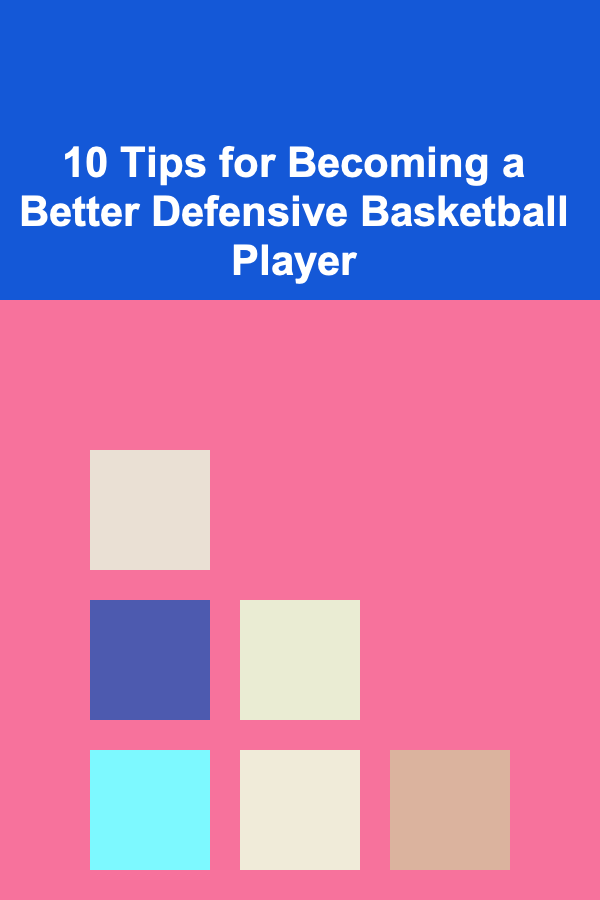
10 Tips for Becoming a Better Defensive Basketball Player
ebook include PDF & Audio bundle (Micro Guide)
$12.99$11.99
Limited Time Offer! Order within the next:

Becoming a top-tier defensive basketball player is one of the most rewarding pursuits in the game. Defense is often seen as the foundation of a great basketball team, and many of the best players in history have made their names with their defensive prowess. While offensive skills such as shooting and scoring often steal the spotlight, the ability to stop your opponent from scoring is just as important---if not more so. Whether you are a beginner or looking to elevate your game to the next level, becoming a more effective defender will enhance your overall performance on the court.
In this article, we will explore 10 essential tips to help you become a better defensive basketball player, focusing on the fundamentals and advanced techniques that contribute to a well-rounded defensive skill set.
Master the Fundamentals of Defensive Stance
A strong defensive stance is the foundation of all good defense. Without it, you'll struggle to stay in front of your opponent and react quickly to their movements. To be effective on defense, you must position yourself low to the ground, ready to pivot and move in any direction.
Key Elements of a Good Defensive Stance:
- Knees Bent: Lower your body to increase your balance and allow for quicker reactions.
- Wide Base: Position your feet shoulder-width apart to provide stability and agility.
- Hands Active: Keep your hands up and ready to contest shots, deflect passes, and swipe at the ball.
- Head Up: Always keep your head up so you can see both the ball and your opponent's movements.
The key to mastering the defensive stance is consistency. Every time you step onto the court, make sure your posture is correct and ready for any situation that may arise.
Develop Lateral Quickness
Being able to move side-to-side quickly is essential for staying in front of your man. If you lack lateral quickness, it becomes much easier for your opponent to get past you. The ability to slide efficiently, without crossing your feet or losing balance, is essential for effective man-to-man defense.
Drills to Improve Lateral Quickness:
- Defensive Slides: Perform quick side-to-side slides while staying in a low stance. Focus on keeping your feet wide and shifting your weight smoothly between legs.
- Cone Drills: Set up cones in a zigzag pattern and quickly move around them while maintaining a strong defensive stance.
- Ladder Drills: Use an agility ladder to improve footwork, ensuring you stay low and move laterally with precision.
Improving your lateral quickness will make it much harder for opponents to blow by you and create scoring opportunities.
Anticipate Your Opponent's Moves
Effective defenders don't just react---they anticipate. Reading your opponent's body language and the offense's tendencies will give you an advantage. A great defensive player can predict a player's next move, whether it's a drive, a pass, or a screen.
How to Improve Anticipation:
- Watch the Ball: Always keep an eye on the ball to understand the offensive flow. When your opponent holds the ball for an extended period, it's a good opportunity to read their body language and predict their next move.
- Study Opponent Patterns: Before or during a game, study your opponent's tendencies. Do they prefer driving left? Are they more likely to pull up for a jumper when they get a screen? Understanding their habits will help you predict and intercept their actions.
- Watch the Hands: The hands often give away the next move. A ball handler's dribbling movements or the way they prepare to shoot can provide you with clues about their intentions.
Anticipating your opponent's next move allows you to be one step ahead, forcing them to adjust and possibly make mistakes.
Use Your Feet, Not Your Hands
Many players make the mistake of relying too much on their hands when playing defense, whether it's trying to swipe at the ball or reaching in for a steal. This often leads to fouls or missed opportunities. Instead, focus on using your feet to stay in front of your opponent.
Why Feet Are More Important Than Hands:
- Less Likely to Foul: Using your feet to slide and stay in front of your opponent reduces the chance of making illegal contact, which results in fouls.
- Better Control: Your feet control your positioning. If you focus on staying balanced and mobile, it will be easier to react to your opponent's movements.
- Prevent Dribble Penetration: By using your feet to control the space between you and your opponent, you can prevent them from easily driving past you.
If you can use your feet to stay in front of the ball handler while keeping your hands active for contests or steals, you'll be an impenetrable force.
Become an Expert at Defending without the Ball
Defense isn't only about guarding the ball handler; it's also about positioning and reading the play when you don't have the ball. Great defenders know how to help their teammates, guard off-ball screens, and prevent easy cuts to the basket.
Key Aspects of Off-Ball Defense:
- Closeouts: When closing out on a shooter, sprint towards them, but make sure to stop short and slide into your defensive stance to avoid being faked out by a pump fake.
- Watch the Ball and Man: When guarding a player off the ball, always be aware of both the ball's location and the player you're guarding. This will help you anticipate cuts and pass attempts.
- Fight Through Screens: Screens are one of the most difficult aspects of defense. Focus on staying low and using your footwork to fight over or under screens to stay attached to your man.
Off-ball defense is often overlooked, but it can make all the difference when it comes to stopping an offense from getting easy looks.
Learn to Contest Shots Effectively
Being a good defender isn't just about stopping your opponent from getting by you; it's also about contesting their shots without fouling. You want to challenge their shots to make them more difficult, but without making contact and sending them to the free-throw line.
Tips for Effective Shot Contesting:
- High Hands: Always get your hands up to contest shots, making it difficult for the shooter to get a clean look.
- Stay Vertical: Avoid jumping into the shooter's space. Instead, jump straight up to challenge the shot without making unnecessary contact.
- Know the Shooter: Understand whether your opponent is a good shooter or a streaky one. If they are a great shooter, make sure you're more aggressive in contesting their shot.
A well-timed contest can significantly reduce an opponent's shooting percentage, and it doesn't always require you to block the shot.
Communicate Constantly on Defense
Defense is a team effort, and communication is critical. Constantly talking to your teammates helps everyone stay on the same page, whether it's calling out screens, switches, or helping on a drive.
Key Communication Cues:
- "Screen Left/Right": Alerting teammates about an oncoming screen can help them prepare for the offensive player's movement.
- "Help!": Calling for help when a player is beaten off the dribble or needs assistance can prevent easy baskets.
- "I Got Ball": Letting your teammate know that you're ready to pick up the ball handler and don't need a switch.
Being vocal on defense creates a sense of unity and makes it easier to execute complex defensive schemes.
Take Advantage of Transition Defense
Good transition defense is key to preventing easy fast-break points. If your team is transitioning from offense to defense, it's crucial to sprint back and locate your man or find the open shooter.
Tips for Effective Transition Defense:
- Sprint Back: Always make it a priority to get back on defense. Even if you're the last one down the court, making a quick transition can prevent the other team from getting an easy layup.
- Stop the Ball: If you're the first player back, try to stop the ball handler at the top of the key to slow down the offense and allow your teammates to set up their defense.
- Find Your Man: As soon as you cross half-court, locate the player you're supposed to guard and deny them easy access to the basket.
Preventing fast breaks can often be the difference between a tight game and a blowout.
Learn the Art of Taking Charges
Taking a charge is one of the most selfless plays in basketball. It requires a defender to stand firm and take the full impact of a driving offensive player, but if executed correctly, it can swing momentum in your favor.
Tips for Drawing a Charge:
- Positioning: Be in proper position before the offensive player starts their drive. Get both feet planted on the ground, and make sure you're not moving.
- Stay Calm: Don't flinch when the ball handler comes towards you. Stay composed and absorb the contact.
- Timing: Know when to stand your ground. If you take the charge too early or too late, it might not count. Timing is everything.
Drawing charges can help you get key stops and even give your team an emotional lift.
Maintain a Strong Mental Attitude
Finally, defense is just as much about mindset as it is about physical ability. A great defender needs to have the mental fortitude to stay locked in, especially during tough situations.
Mental Tips for Defense:
- Stay Positive: Even if you get beaten once, don't let it affect your confidence. Great defenders bounce back and remain focused.
- Be Consistent: Consistency is key to becoming a better defender. Always bring your best effort on every possession.
- Accept the Challenge: Embrace the challenge of guarding the opponent's best player. Being the defender that your team relies on is a badge of honor.
With the right mentality, you can elevate your defense and make a real impact on the game.
Improving your defense is a gradual process that requires time, commitment, and a willingness to constantly learn and improve. By implementing these 10 tips into your game, you will become a more effective defender and contribute significantly to your team's success. Keep working on your skills, and soon you'll find yourself making a difference on both ends of the court.
Reading More From Our Other Websites
- [Metal Stamping Tip 101] Best Approaches to Reducing Burr Formation in Heavy‑Duty Metal Stamping
- [Personal Financial Planning 101] How to Maximize Your Retirement Contributions
- [Organization Tip 101] How to Use a Calendar to Track School Assignments and Supplies
- [Home Cleaning 101] How to Clean a Kitchen: A Comprehensive Guide to Decluttering and Sanitizing
- [Screen Printing Tip 101] Step-by-Step Guide: DIY Screen Printing Projects Using Everyday Paper
- [Metal Stamping Tip 101] How to Conduct Failure Analysis on Stamped Parts That Deviate From Specifications
- [Home Party Planning 101] How to Make Your Home Party More Interactive with Fun Activities
- [Personal Investment 101] How to Maximize Your Returns with Real Estate Investments
- [Home Security 101] How to Install a DIY Security Camera System
- [Soap Making Tip 101] Best Artisan Soap Designs Inspired by Traditional Japanese Patterns

How to Celebrate Financial Milestones with Your Family
Read More
How to Clean Your Windows for a Sparkling Shine
Read More
How to Cook for a Crowd with Ease
Read More
How to Set Up an Efficient Home Office Space
Read More
One-Page Website SEO: How to Use Keywords Without Overstuffing
Read More
How to Create a Newborn Sleep Schedule (Even with Frequent Feedings)
Read MoreOther Products

How to Celebrate Financial Milestones with Your Family
Read More
How to Clean Your Windows for a Sparkling Shine
Read More
How to Cook for a Crowd with Ease
Read More
How to Set Up an Efficient Home Office Space
Read More
One-Page Website SEO: How to Use Keywords Without Overstuffing
Read More